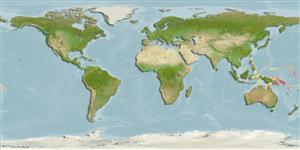Classification / Names
Common names | Synonyms | Catalog of Fishes (gen., sp.) | ITIS | CoL | WoRMS | Cloffa
Actinopterygii (ray-finned fishes) >
Perciformes (Perch-likes) >
Pomacentridae (Damselfishes) > Pomacentrinae
Etymology: Chromis: Greek, chromis = a fish, perhaps a perch (Ref. 45335); howsoni: Named for Craig Howson, a friend of the author.
Environment / Climate / Range
Ecology
Marine; reef-associated; depth range 2 - 65 m (Ref. 96316), usually 6 - 20 m (Ref. 96316). Tropical, preferred ?
Western Pacific: Papua New Guinea.
Size / Weight / Age
Maturity: Lm ? range ? - ? cm
Max length : 5.6 cm SL male/unsexed; (Ref. 96316)
Short description
Morphology | Morphometrics
Dorsal
spines
(total): 11 - 12;
Dorsal
soft rays
(total): 11-13;
Anal
spines: 2;
Anal
soft rays: 12 - 13;
Vertebrae: 26. This species is distinguished by the following set of characters: D XI or XII,11-13 (usually XII, 13); A II,12-13 (rarely 13); pectoral rays 15-17 (rarely 17); spiniform caudal rays 2; tubed lateral-line scales 12-14 (usually 13); total gill rakers on first branchial arch 27-31; body depth 1.6-1.8 in SL; colour in life yellowish brown grading to grey brown on posterior body including caudal peduncle; orange bar across pectoral-fin base, invading axil of fin; pelvic fins are yellow; dorsal and anal fins are brown with yellow area posteriorly on each fin; dark brown margin, dorsally and ventrally on caudal fin, tapering in width posteriorly (Ref. 96316).
Prefers gentler slopes of coral-rich areas of highly sheltered lagoons and bays, and also on steep outer reef slopes where it can be found in the vicinity of crevices and caverns (Ref. 96316).
Life cycle and mating behavior
Maturity | Reproduction | Spawning | Eggs | Fecundity | Larvae
Allen, G.R., 2014. A new species of damselfish (Chromis: Pomacentridae) from Papua New Guinea. J. Ocean Sci. Found. 11:13-22. (Ref. 96316)
IUCN Red List Status (Ref. 115185)
CITES (Ref. 94142)
Not Evaluated
Threat to humans
Harmless
Human uses
More information
Common namesSynonymsMetabolismPredatorsEcotoxicologyReproductionMaturitySpawningFecundityEggsEgg development
Age/SizeGrowthLength-weightLength-lengthLength-frequenciesMorphometricsMorphologyLarvaeLarval dynamicsRecruitmentAbundance
ReferencesAquacultureAquaculture profileStrainsGeneticsAllele frequenciesHeritabilityDiseasesProcessingMass conversion
Tools
Special reports
Download XML
Internet sources
